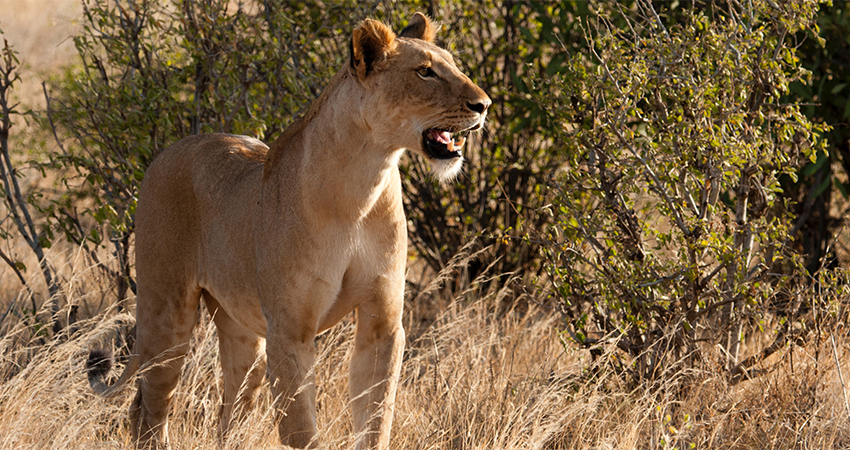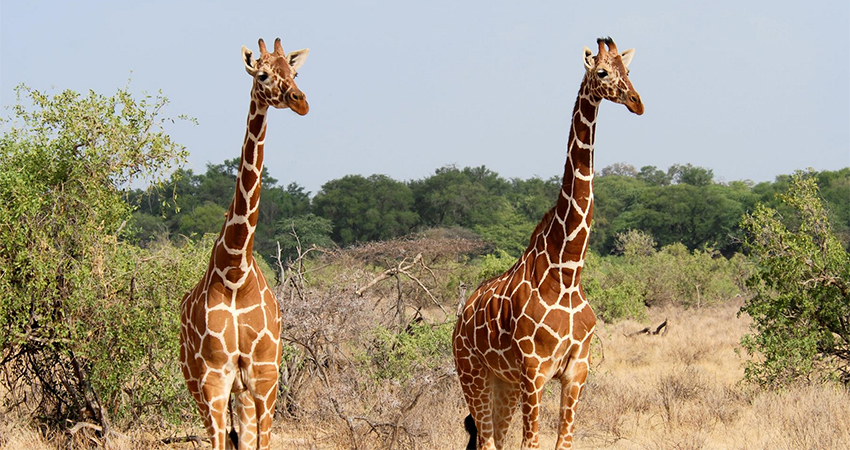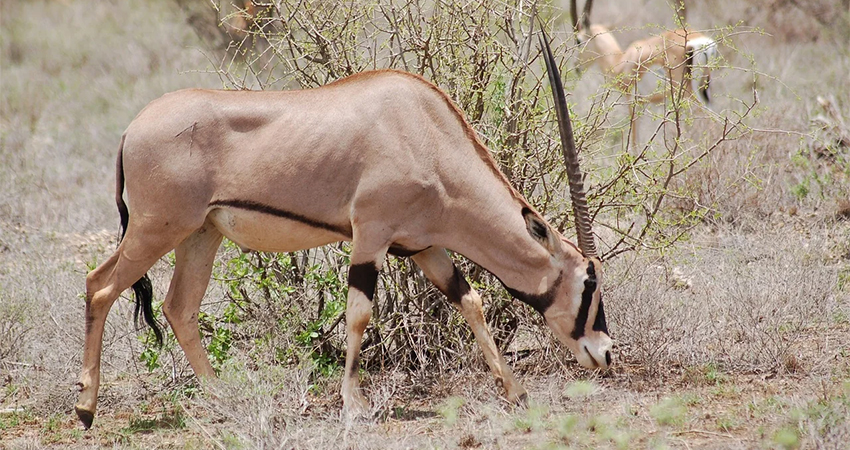The Beginner’s Travel Guide To Explore Samburu National Reserve in 3 Days

Samburu National Reserve is a rugged and semi-desert park located in Samburu district in the Rift Valley Province of Kenya. The park neighbors the homes of the Samburu tribe of Kenya, a tribe known for their remote culture, pastoral and nomadic way of life.
Due to its remote distance and the fact that it was inaccessible for many years, the park has retained a naturally serene and quiet feeling. Besides the numerous wildlife found in this game reserve, the park is also a bird haven.
The most famous and most visited attraction of Samburu Land is Samburu National Reserve on the northern banks of Ewaso Nyiro river, a unique natural gem covering 165 sq km, which makes it neither Kenya’s nor the County’s largest nature reserve. But wildlife variety and density is amongst the highest in the country, possibly second only to the Masai Mara.
It is especially known for high elephant numbers and the rare dry land fauna of northern Kenya, the ‘Samburu Five’ comprising of Beisa oryx, Somali ostrich, reticulated giraffe, gerenuk and Grevy’s zebra. All in all, there are 50 species of larger mammals identified in Samburu National Reserve, amongst them the great cats lion, leopard and cheetah, as well as impala, greater and lesser kudu and a prolific birdlife, of which hornbill, vulturine Guinea fowl, weaver birds and various birds of prey are the most conspicuous.
Samburu National Reserve’s scenic landscape is an experience in its own, combining undulating landscapes of doum palm fringed river banks, bold rocky outcrops and vast grassland savannah with acacia trees.
Within the Reserve and at its fringes, there are wonderfully set lodges and safari camps. Not surprisingly, Samburu National Reserve boasts the best tourist infrastructure of all conservation areas in northern Kenya and guarantees its visitors an unforgettable safari experience.
Overview & summary – background information about Samburu National Reserve
Samburu National Reserve is situated within the Rift Valley Province of Kenya. Measuring approximately 104sq. kilometers (approx. 65sq. miles) in size, this unfenced Savannah grassland is roughly 350km (217 miles) from Nairobi. It is relatively small in size compared to other Kenyan parks, such as Tsavo or Masai Mara.
Samburu national reserve derives its name from the Samburu people of Kenya who have lived in the area for many years.
The Uaso Nyiro River cuts through this reserve, drawing a big population of Kenya animals to the park. The river bustles with activity from its huge population of Nile crocodile.
The reserve’s topography is mainly open Savannah (grassland) with clusters of acacia trees, forest, thorn trees and grassland vegetation.
Samburu National Reserve was one of the two areas in which conservationists George and Joy Adamson raised Elsa the Lioness. Their story was made famous by the bestselling book and award-winning movie “Born Free”.
The game reserve is renowned for its rare species of animals unique to the park, namely: the long necked gerenuk, Grevy’s zebra, reticulated giraffe and Beisa onyx. The elusive Kenya leopard is often known to visit the park, especially in the evenings.
Other Kenyan wildlife present in the park includes cheetahs and lions, as well as elephants, buffalo and hippos.
Bird life is as plentiful as wildlife at Samburu National Reserve, which boasts over 350 different species of birds including vultures, kingfishers, marabous, bateleurs, guinea fowl, Somali ostriches and others.

Samburu National Reserve facts
Samburu National Reserve – weather and climate
The climate in Samburu is hot and dry during the day, and cool during nights and evenings.
Average maximum temperatures are around 30°C (85°F) with minimum temperatures of approximately 20°C. Most rain falls between March and May, with short rains falling from November to December, recording a total maximum rainfall of 350mm. July through October and January through March are mainly hot and dry.
How to get to Samburu National Reserve
By Road: Book with City Sightseeing Tours to take you there with an open-topped minibus or safari van tour with a tour guide. The park is located about 345km (approx. 214 miles) from Nairobi, or about a five-hour drive. The roads and tracks to the park are all weather. The reserve is accessible by road via Isiolo and Archer’s Post.
By Air: The game reserve is accessible by air and there are daily flights from Nairobi to Samburu that you can book online. Travel time is about 45 minutes and the flights land at the park’s airstrip. Private charter flights are also allowed to use the airstrip.
What to see and what to do in Samburu – Attraction
Game Viewing: In the southern part of the park, you are guaranteed to see most of the Kenyan animals found in Samburu, namely: cheetahs, lions, leopards, impalas, buffalo, hippos, and dik-diks, as well as the native gerenuk, Grevy’s zebra, reticulated giraffe and Beisa Oryx. You are guaranteed to see most animals during the dry season as they converge at the Usaso Nyiro River, their main source of water during the long dry weather. Elephants are also spotted during this time, and you can watch the Nile crocodiles swim in the river.
Bird Viewing: Samburu National Reserve is a paradise for bird lovers, with over 350 species of birds already recorded. You can enjoy a colorful assortment of birds such as vultures, kingfishers, marabous, bateleurs, guinea fowl, Somali ostriches and many more.

Samburu Cultural Tours: Visit the local Samburu villages where you get a chance to interact with the colorful Samburu people in their traditional setting and experience their culture. This is a good opportunity to purchase traditional Samburu souvenirs, art and collectibles.
Buffalo Springs Reserve – Just south of Samburu Reserve on the opposite side of the Ewaso Ng’iro river lies Buffalo Springs, named for an oasis here. Similar wildlife can be found near an ancient lava terrace called the Champagne Ride.
Buffalo Springs is linked to Samburu to the south by a bridge crossing the Ewaso Ng’iro which was built in 1964. It shares much of the same wildlife as Samburu but intriguingly is also home to the common zebra not found just over the bridge on the north side of the river.
A crater in the park was created by some misjudged bombing by an Italian pilot in the Second World War. It has since become a clear water pool and is apparently safe to swim in.
Shaba National Reserve – To the east of Samburu and Buffalo Springs is Shaba Reserve. Greener than Samburu, the reserve is an area of dramatic forests, woodlands and volcanic formations, especially the Shaba Hill Volcano.The 3rd and largest of the 3 linked reserves is Shaba National Reserve (246 sq km).
The park is names after the sandstone Mount Shaba which lies partially within the reserve and 5000 years ago oozed lava down the Nyambeni Hills. With 4 springs Shaba is ironically better watered than Buffalo Springs or Samburu. Heavy rainfall can make the tracks only suitable for 4 wheel drive vehicles which adds to its reputation of exclusivity for many travellers seeking a ‘genuine’ Kenyan experience.
Heavy poaching has made the local wildlife shy although it is still possible to see elephant, cheetah, waterbuck and leopard as well as the mammals which are adapted for the harsher conditions of the north as seen in the Samburu Reserve.
Best time to visit Samburu – Rates and fees
The months of December through March and July through October are dry, making them by far the best months to visit the Samburu National Reserve. April through June are also good months but might be rainy.
Park schedule and rates
The park is open all year round.
Park entrance fees – you can ask for the latest entrance rates for both citizens and non-citizens. Samburu National Reserve is managed by the county council of Samburu.
Where to book your Safari tour to Samburu National Reserve
Booking a wildlife safari, bird watching safari or scenic safari to Samburu is easy. You can book the safari online yourself to travel individually or as a group. There are also reputable travel agents and Kenya tour companies who will book a guided, all-inclusive Kenya safari tour for you before your arrival.
One of the option we recommend our visitors is to book these Kenya tour and travel safari packages which normally include accommodation, travel to the park, park fees, English-speaking tour guides, food and other activities to capture that memorable experience in Samburu National Reserve and other safari parks in Kenya.




